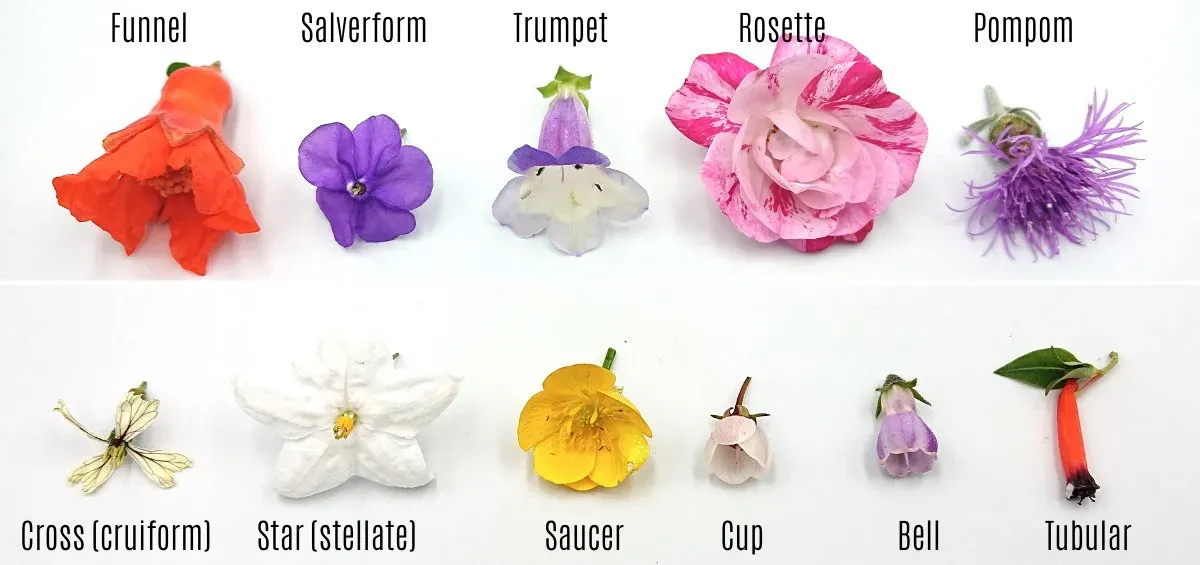Table of Contents
Ever stopped to really *look* at a flower? I mean, *really* look? Beyond the pretty colors, there's a whole hidden world of shapes and forms waiting to be discovered. We're talking about Petal shapes, the building blocks of floral beauty. At lilyflower.homes, we believe that appreciating the natural world is key to understanding its wonders. This article will take you on a process through the fascinating variety of petal shapes found in nature. We'll explore the different types, their significance in art and design, and even the scientific reasons behind their unique forms. Get ready to see flowers in a whole new light! We'll look at how petal shapes influence everything from the way a flower attracts pollinators to how artists use them to create stunning works of art. So grab a cup of tea, settle in, and prepare to be amazed by the intricate beauty of petal shapes.

Amazing Petal Shapes: A Stunning Guide
Petal Shapes: A Colorful World of Forms

Petal Shapes A Colorful World Of Forms
Understanding the Diversity of Petal Shapes
As an avid flower enthusiast, I'm always fascinated by the intricate details of petals. Petal shapes are more than just a aesthetically pleasing aspect of flowers; they play a crucial role in the plant's reproduction and survival. From the delicate petals of roses to the bold, trumpet-shaped blooms of lilies, each petal shape has its unique characteristics and functions.
For instance, did you know that the shape of a petal can influence the type of pollinator it attracts? Certain shapes, like the long, tube-shaped petals of honeysuckle, are specifically designed to attract hummingbirds and other long-tongued pollinators. This is because the shape of the petal allows these pollinators to easily access the nectar deep within the flower.
Petal Shape | Pollinator Attracted | Function |
|---|---|---|
Tubular | Hummingbirds, bees | Provides access to nectar |
Trumpet-shaped | Bees, butterflies | Guides pollinators to nectar |
Flat | Bees, wasps | Allows for easy landing and access to nectar |
Types of Petal Shapes
Petal shapes can be broadly classified into several categories, including:
- Zygomorphic: symmetrical on one plane
- Actinomorphic: symmetrical on multiple planes
- Cyanthiform: cup or tube-shaped
- Cruciform: cross-shaped
These categories are not exhaustive, and many flowers exhibit unique petal shapes that don't fit neatly into one category. However, understanding these basic shapes can help you appreciate the diversity and complexity of petals in the plant kingdom.
If you're interested in learning more about the science behind petal shapes, I recommend checking out our post on humidity preferences and how they affect flower growth.
Appreciating Petal Shapes in Art and Design
Petal shapes have been a source of inspiration for artists and designers for centuries. From the intricate patterns on a butterfly's wings to the bold, geometric shapes of modern art, petals have been used to create stunning works of art.
Want to learn more about the intersection of art and nature? Check out our post on flower color and how it's used in art and design.
Exploring Different Petal Shapes and Their Significance

Exploring Different Petal Shapes And Their Significance
Why Petal Shapes Matter
Petal shapes aren't just about looking pretty; they play a crucial role in a flower's survival and reproduction. Think of a flower as a living billboard, trying to attract the right pollinators. The shape of the petals acts like a signpost, guiding bees, butterflies, and other critters right to the nectar. For example, the long, tube-shaped petals of honeysuckle are perfect for attracting hummingbirds, which have long beaks to reach the nectar at the bottom.
Imagine a bee buzzing around a garden. It's drawn to the bright, flat petals of a daisy because these petals make it easy to land and find the nectar. It's like a landing strip for the bee, ensuring it can quickly and efficiently pollinate the flower. Understanding these shapes helps us appreciate the intricate design of nature and how everything fits together perfectly.
Petal Shape | Pollinator Attracted | Function |
|---|---|---|
Tubular | Hummingbirds, bees | Provides access to nectar |
Trumpet-shaped | Bees, butterflies | Guides pollinators to nectar |
Flat | Bees, wasps | Allows for easy landing and access to nectar |
Common Petal Shapes and Their Unique Features
Let's investigate into some of the most common petal shapes and what makes them special. Zygomorphic flowers, like the snapdragon, are symmetrical on one plane. This means if you cut them in half, they'd look the same on both sides. Actinomorphic flowers, such as the daisy, are symmetrical on multiple planes. Cut them in half any way you like, and they'll look the same. Isn't that cool?
Then there are cyanthiform flowers, which have petals that form a cup or tube. These are great for holding nectar and attracting specific pollinators. Cruciform flowers, like those of the mustard plant, have petals arranged in a cross shape. Each shape has evolved to serve a specific purpose, making flowers not just beautiful but also highly functional.
- Check out our guide on container growing to see how different petal shapes thrive in pots.
- Learn more about and how they affect the shape and health of petals.
Petal Shapes in Art, Design, and Photography

Petal Shapes In Art Design And Photography
Petal Shapes: A Muse for Artists
Have you ever stopped to think about how petals inspire art? It's pretty amazing when you realize how much of an impact they have. Artists have been using petal shapes in their work for centuries, from the delicate brushstrokes of impressionists to the bold, geometric designs of modern art. Each petal shape brings a unique vibe to a piece, whether it's the soft, flowing curves of a rose or the sharp, pointed edges of a lily.
Take a look at the works of Georgia O'Keeffe, for example. She's famous for her large, close-up paintings of flowers, where the petal shapes are magnified and almost abstract. Her paintings capture the essence of the flower, making the petal shapes the star of the show. This kind of art makes you see flowers in a whole new light. If you're interested in more about how plants grow and thrive, check out our guide on .
Artist | Famous Work | Petal Shape Highlighted |
|---|---|---|
Georgia O'Keeffe | Jimson Weed | Trumpet-shaped |
Vincent van Gogh | Irises | Cyanthiform |
Alphonse Mucha | The Seasons | Actinomorphic |
Petal Shapes in Photography
Petal shapes are not just a hit in paintings; they also shine in photography. Photographers love capturing the intricate details of petals, from the way light plays on their surfaces to the subtle gradients of color. A great example of this is macro photography, where the focus is so tight that you can see every tiny detail of a petal. It's like stepping into a different world, where the smallest parts of a flower can look like landscapes.
One of the most famous photographers known for his flower portraits is Robert Mapplethorpe. His black and white images of lilies are iconic, showcasing the graceful lines and shapes of the petals. The way he captures the texture and form of the petals is nothing short of magical. If you want to learn more about how to care for lilies, check out our .
- Explore more about and how it influences design.
- Learn how can enhance the growth and beauty of your flowers.
The Science Behind Petal Shapes: Why Do They Vary?
Hey there, fellow flower fanatic! So you're diving into the world of petal shapes? Awesome! It's like discovering a secret code written in nature's own language. Why are petal shapes so diverse? Well, it's all about survival of the fittest – or, in this case, survival of the *flower-est*. Think of a flower's petals as its advertising billboards. They're shouting, "Look at me! I have delicious nectar!" to attract pollinators like bees, butterflies, and even hummingbirds.
Different shapes attract different pollinators. Long, tubular petals, like those of a honeysuckle, are perfect for hummingbirds with their long beaks. Flat, wide petals, like those on a daisy, are landing pads for busy bees. It's all a carefully designed system. Want to learn more about creating the perfect environment for your flowers to thrive? Check out our guide on humidity preferences. The shape of the petal isn't just about attracting pollinators; it also protects the flower's reproductive parts, the stamens and pistils. Some petals even act as shields against rain or harsh sunlight.
Petal Shape | Pollinator | Adaptation |
|---|---|---|
Tubular | Hummingbirds | Nectar deep inside, accessible by long beaks |
Flat, open | Bees | Easy landing platform |
Curled | Butterflies | Provides a perch |
But it's not just about the pollinators. The environment also plays a huge role. Flowers in windy areas might have smaller, more tightly closed petals to protect their precious pollen. Flowers in sunny climates might have larger petals to capture more sunlight. It's all interconnected, a beautiful dance between the flower, the pollinator, and the environment. And sometimes, petal shapes are just plain weird and wonderful, a testament to nature's endless creativity. Need help keeping your lilies healthy and happy? Our lily care guide has got you covered!
Imagine you're a flower. You need to get your pollen to another flower of your kind to make seeds and babies! You've got limited resources, so you need to make the most of what you have. Your petals are your best tool. They attract the right pollinators and protect your reproductive parts. The shape and color of your petals are just part of your overall strategy for survival. This is why different flowers have different petal shapes. It's all about finding the perfect balance between attracting pollinators and surviving in your specific environment. For more tips on keeping your lilies healthy, check out our post on watering lilies.
- Petal shape influences pollinator attraction.
- Environmental factors shape petal development.
- Unique petal shapes reflect evolutionary adaptations.
Sometimes, the simplest explanation is the best. Evolution has shaped petal shapes through natural selection. Those flowers with petal shapes best suited to their environment and pollinators were more successful at reproducing, passing on their genes—and petal shapes—to future generations. It’s a beautiful example of how nature constantly adapts and evolves. And let's not forget the sheer beauty of it all – the incredible variety of shapes, colors, and sizes found in the plant kingdom.
Think about it – the next time you see a flower, take a moment to appreciate the incredible story written in its petals. Each shape is a unique solution to a survival problem, a testament to the strength of natural selection. Want to know more about how different environments affect flower growth? Learn about sunlight needs for optimal growth. It’s fascinating stuff!
Final Thought
From the simple elegance of a daisy to the complex symmetry of an orchid, petal shapes are a testament to nature's incredible creativity. Understanding these shapes not only enhances our appreciation of the natural world but also unlocks a deeper understanding of the science and art behind floral design. So next time you encounter a flower, take a moment to appreciate the unique beauty of its petals – you might be surprised at what you learn.